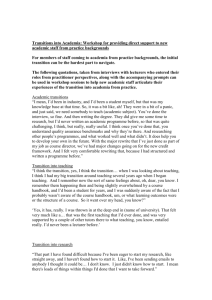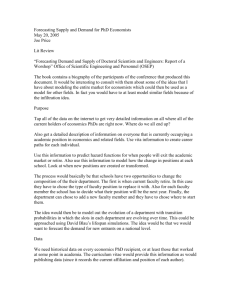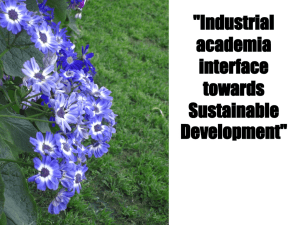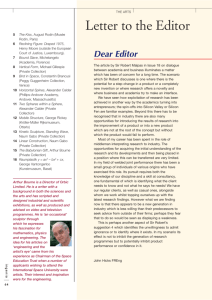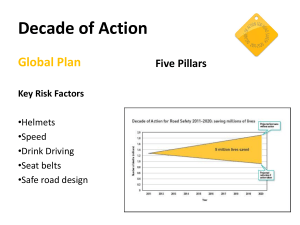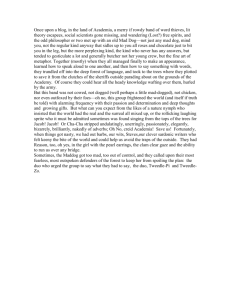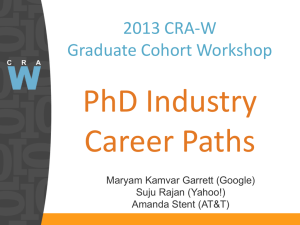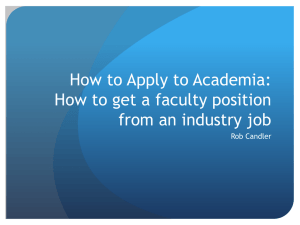Resistance To Technology: A Theory Building Study
advertisement
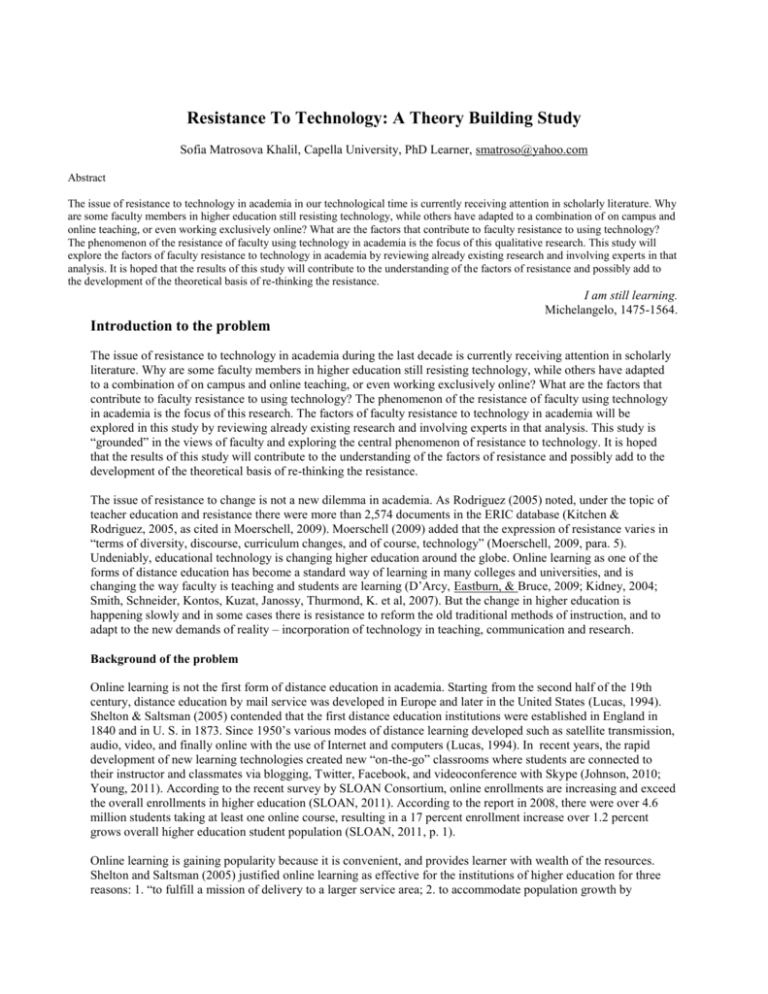
Resistance To Technology: A Theory Building Study Sofia Matrosova Khalil, Capella University, PhD Learner, smatroso@yahoo.com Abstract The issue of resistance to technology in academia in our technological time is currently receiving attention in scholarly literature. Why are some faculty members in higher education still resisting technology, while others have adapted to a combination of on campus and online teaching, or even working exclusively online? What are the factors that contribute to faculty resistance to using technology? The phenomenon of the resistance of faculty using technology in academia is the focus of this qualitative research. This study will explore the factors of faculty resistance to technology in academia by reviewing already existing research and involving experts in that analysis. It is hoped that the results of this study will contribute to the understanding of the factors of resistance and possibly add to the development of the theoretical basis of re-thinking the resistance. I am still learning. Michelangelo, 1475-1564. Introduction to the problem The issue of resistance to technology in academia during the last decade is currently receiving attention in scholarly literature. Why are some faculty members in higher education still resisting technology, while others have adapted to a combination of on campus and online teaching, or even working exclusively online? What are the factors that contribute to faculty resistance to using technology? The phenomenon of the resistance of faculty using technology in academia is the focus of this research. The factors of faculty resistance to technology in academia will be explored in this study by reviewing already existing research and involving experts in that analysis. This study is “grounded” in the views of faculty and exploring the central phenomenon of resistance to technology. It is hoped that the results of this study will contribute to the understanding of the factors of resistance and possibly add to the development of the theoretical basis of re-thinking the resistance. The issue of resistance to change is not a new dilemma in academia. As Rodriguez (2005) noted, under the topic of teacher education and resistance there were more than 2,574 documents in the ERIC database (Kitchen & Rodriguez, 2005, as cited in Moerschell, 2009). Moerschell (2009) added that the expression of resistance varies in “terms of diversity, discourse, curriculum changes, and of course, technology” (Moerschell, 2009, para. 5). Undeniably, educational technology is changing higher education around the globe. Online learning as one of the forms of distance education has become a standard way of learning in many colleges and universities, and is changing the way faculty is teaching and students are learning (D’Arcy, Eastburn, & Bruce, 2009; Kidney, 2004; Smith, Schneider, Kontos, Kuzat, Janossy, Thurmond, K. et al, 2007). But the change in higher education is happening slowly and in some cases there is resistance to reform the old traditional methods of instruction, and to adapt to the new demands of reality – incorporation of technology in teaching, communication and research. Background of the problem Online learning is not the first form of distance education in academia. Starting from the second half of the 19th century, distance education by mail service was developed in Europe and later in the United States (Lucas, 1994). Shelton & Saltsman (2005) contended that the first distance education institutions were established in England in 1840 and in U. S. in 1873. Since 1950’s various modes of distance learning developed such as satellite transmission, audio, video, and finally online with the use of Internet and computers (Lucas, 1994). In recent years, the rapid development of new learning technologies created new “on-the-go” classrooms where students are connected to their instructor and classmates via blogging, Twitter, Facebook, and videoconference with Skype (Johnson, 2010; Young, 2011). According to the recent survey by SLOAN Consortium, online enrollments are increasing and exceed the overall enrollments in higher education (SLOAN, 2011). According to the report in 2008, there were over 4.6 million students taking at least one online course, resulting in a 17 percent enrollment increase over 1.2 percent grows overall higher education student population (SLOAN, 2011, p. 1). Online learning is gaining popularity because it is convenient, and provides learner with wealth of the resources. Shelton and Saltsman (2005) justified online learning as effective for the institutions of higher education for three reasons: 1. “to fulfill a mission of delivery to a larger service area; 2. to accommodate population growth by increasing enrollment without spending money on building and land; 3. to reach a wider student population by gathering more potential students who otherwise wouldn’t be able to attend classes” (p. 6). The educational methodology of online education is considered no longer experimental and benefits, access and flexibility of such learning understood by many institutions of higher education (Berge & Muilenburg, 2001). Yet, some institutions are not making “changes necessary to maximize the effectiveness and efficiency of online learning” (Howard, Schenk & Discentza, 2004, as sited in Shelton, & Saltsman, 2005, p. 7). Statement of the problem The problem is that in many colleges and universities, some faculty members still resist using educational technology in their work. A great deal of literature has been written on the issue of resistance in academia (Berge, 2001; Howard, Schenk & Discentza, 2004; Rodriguez, 2005; Shelton & Saltsman, 2005; Moerschell, 2009; Moore, 1994). This study will investigate both resistance and methods for changing faculty behavior towards the use of technology. The available research on the factors behind faculty resistance to change their current ways of teaching and adapting to the use of technology in instruction, points to the need for continuing research on how to overcome those factors of resistance and bring educational technology to the classroom. Also, the available research shows that there is lack of any general theory of resistance to technology (Oreg, 2006). This study aims to fulfill such a deficiency, and to contribute to the development of the theory of resistance to technology. Purpose of the study The purpose of this qualitative study that uses grounded theory is to analyze the phenomenon of faculty resistance to technology in academia and to add to the development of the theoretical basis for re-thinking the resistance. This study is seen as an identification of the process of change from resistance to learning and accepting technology. Organizational change is needed to overcome the factors of faculty resistance in using technology. The input of the experts in the field of resistance and change process will contribute to the development of the theory of resistance to technology. The significance of this study Although much of research is done on the factors of faculty resistance to technology and resistance to change in academia, the fact of the resistance remains. The question is: “How one can use the rich data on resistance to change faculty attitudes?” Several authors propose to ‘rethink’ resistance to change in order to help employees to go though the change in an organization (Diamond, 1986, Piderit, 2000, Oreg, 2006). Throughout the thorough literature review this researcher acquired a concrete feeling that this research is not about piloting an additional survey of faculty on the factors of resistance to technology. It was done before. This research is about combining the many survey results of the previous research on the factors/barriers/resistance of faculty to technology in one new analysis. The factors of resistance varying from one research study to another research, as well as the recommendations for improving this situation. There is a need to organize those factors so the picture of faculty resistance to technology will reveal in all its details. To treat the problem one should identify its causes. The categorization of the many causes of resistance presented as one clear document, which could be used as a blue print, would be helpful for faculty and leadership to recognize the factors that cause resistance and to create a path for overcoming the problem. The significance of this proposed study is in examination and categorization of the factors of resistance that can help to understand the causes of the problem. First, the results of the proposed study might be used by administration and leadership in institutions of higher education as a “blue print” to identify the specific factors of resistance in their institutions and to try to find solutions to overcome those factors, and help faculty to learn about and use technology in their work. Second, such an understanding would be helpful to faculty to see a scope of the issues associated with the resistance, understand them, and to conquer them with the appropriate support of leadership of their institutions. Finally, the results of the study and their implications would be helpful to a wider audience – the students who desire to learn with the use of technology that provides them with variety of resources, convenience to study from remote locations that allows them to balance their busy lives with the ability to advance their education. Research questions The purpose of this qualitative study that uses grounded theory is to analyze the phenomenon of faculty resistance to technology in academia, therefore the main research question is: 1. What are the factors that contribute to faculty members’ resistance to technology in our technologically advanced time? To learn about such a phenomenon the specific subquestions were identified: 2. How can faculty, as adult learners, be prepared to understand technology and to learn about its use in instruction? 3. How can faculty’s reluctance or un-readiness to technology be overcome cognitively through participation in change? 4. How can psychological defensive behavior of faculty as part of emotional and behavioral resistance be transformed from negative to positive attitude towards change? 5. How can cognitive realignment of resistors’ espoused theories and theories-on-use be used to accept the change and use technology in instruction? 6. How can the Control Theory be used by leadership as effective action to generate the knowledge about resistance and to create a path from theory (espoused theory) to practice (theory-in-use) and help faculty to use technology in their work? 7. How can the input of the experts in the field of resistance to technology and change process advance the development of the theory of resistance to technology. Chapter 2: Literature Review The survey of literature for this study was focused on several issues: 1. The evolution of technology in teaching and learning; 2. The theories of teaching adults and the necessity of using technology in teaching adults in academia; 3. The causes and the factors of faculty resistance to use of technology in their work; 4. The Change Resistance Theory in relation to faculty’s resistance to technology; 5. The Control Theory and the role of academic leadership in creating effective and technologically advanced learning environments for all – adult students and faculty equally. The resistance of faculty to changes in utilizing technology in higher education and managing that resistance may be among the most pressing challenges for leaders in academia (Berge & Muilenburg, 2001; Moerschell, 2009). Several authors propose to ‘rethink’ resistance to change, to view the resistance as a multidimensional attitude towards change that consists of three interconnected elements cognitive, affective and behavioral/intentional components, and to help employees to go though the change in an organization (Diamond, 1986; Oreg, 2006; Piderit, 2000). Piderit (2000) summed up that” we should retire the phrase ‘resistance to change,’ and I advocate a new wave of research on employee responses to change, conceptualized as multidimensional attitudes” (para. 37). There is a large body of the literature written on the issue of faculty resistance to technology in academia. To resolve this issue and bring technology into classrooms, faculty (as adult learners) should learn about and use technology in their work (Berge and Muilenburg, 2001; Moerschell, 2009). The theoretical framework chosen for this study is equally applicable to both groups of adult learners in academia – students and faculty alike. In recent years, the cohort of adult learners in academia has changed (Erickson, 2010; Palfrey & Gasser, 2008). In order to effectively teach their adult students, faculty must learn about and use technology in their teaching. Faculty as well as their students is viewed in this study as adult learners, and therefore the theories explained below are fully applicable to faculty as adult learners. The several theories that contribute to the understanding of the specifics of adult learners and their education used in this study are: Knowles’ Theory of Andragogy (1970, 1975, 1980, 1984, 1989, 1998); Bloom’s Cognitive Taxonomy (1956); Rotter's Internal-External Locus of Control Scale (RIELC, Rotter, 1966, 1975); Kolb’s Learning Style Theory (1984, 2005), Erickson’s (2010) characteristics of different generations/age cohorts of adult learners; Rossmans Adult Learning Inventory (RALI, 1990); Change Resistance Theory (Diamond, 1986, Piderit, 2000, Oreg, 2006); Ramsden’s (1998) Theory of Leadership and Theory of Control, and Argyris and Schön’s (1974) Theory of Action. The change resistance theory The theory of resistance to change states that resistance should be viewed as a multidimensional (negative) attitude towards change and it consists of three interconnected elements: cognitive, affective, and behavioral/intentional components (Oreg, 2006; Piderit, 2000). Diamond (1986) stated that remedy for resistance “involves a cognitive realignment of resistors’ espoused theories and their theories-in-use” (para. 18). Piderit (2000) summed up that” we should retire the phrase ‘resistance to change,’ and I advocate a new wave of research on employee responses to change, conceptualized as multidimensional attitudes” (para. 37). Control theory The Leadership Theory and Theory of Control (Ramsden, 1998) and Argyris and Schön’s (1974) Theory of Action is chosen by the author as support to the Theory of Andragogy as the main motif for the study. Ramsden (1998) asserted that it is the role of effective leaders in reframing educational organizations to address the new needs of community learners – the students and the faculty. Genuine learning requires an environment of “trust and an absence of fear, where the academics, like their students will take risks, excel, and do remarkable things” (Ramaden, 1998, p. 268). Ramsden (1998) believed that academic leadership should provide for everyone an “environment for enterprise, bold moves, and imagination – in teaching, research and professional practice” (p. 267). Resistance of faculty to use technology in instruction Several issues were identified through the survey of the literature. Moerschell (2009) in the article Resistance to Technological Change in Academia clearly stated the array of attitudes towards technology from “the old timers who like things as they are” (para. 8-9) to lack of awareness and interest to vision of how technology would benefit them. Moerschell (2009) pointed out several reasons of resistance: a limited vision of the future; b. comfort with the way things are; c. deficits in information and communication; d. the individual’s nature to be uncooperative; e. and, that they do not have the skills to do what the leader is proposing (Bergmann & Brough, 2007, as sited in Moerschell, 2009, para. 13). Moerschell (2009) also reported that the culture in academia is a serious factor of resistance to technology and it “epitomizes this behavior”, and is “a necessary systemic component of implementing technological change” (para. 22). This issue was addressed by many authors such as Bergmann and Brough (2007); Cameron and Green (2004); Horn (2002); and Kitchen and Rodriguez (2005). Berge and Muilenburg (2001) identified 64 barriers or factors of resistance to distance education. The 64 barriers were grouped into 10 factors: 1. Administrative structure – management is of distance learning is problematic; 2. Organizational change - most organizations are resistant to change; 3. Technical expertise professional development and support; 4. Social interaction and quality – isolation of faculty and students, quality of programs, courses, and students learning and assessment; 5. Faculty compensation and time – time consuming, lack of funding; 6. Threatened by technology - replaced by technology? 7. Legal issues Internet and copyright, fair use policies, piracy, intellectual property rights, and problems with hackers and viruses; 8. Evaluation/Effectiveness - concern over a lack of research supporting the effectiveness and evaluation of distance education; 9. Access - lack access or concerns over equal access to courses offered via newer technologies such as Web based instruction for both instructors and students; 10. Student support services - provision of student services such as advisement, library services, admissions, and financial aid-at a distance is a critical facet of any distance learning program (Berge & Muilenburg, 2001). Chapter 3: Methodology Research design This research is a qualitative study that will discuss the phenomenon of faculty resistance to technology in academia and will add to the development of the theoretical basis of re-thinking that resistance. The preliminary review of the literature justifies that there is a need for a study that would gain better understanding of the factors of faculty resistance to using technology. Because of the narrative nature of the proposed research to collect, analyze, and interpret the readily available data on the factors of resistance, the qualitative method with grounded theory inquiry strategy is selected. Data collection instrument For the purpose of this research a focused, but open-ended survey, as a research instrument specifically designed for this research, will be offered to the experts on resistance and change, the obtained data will be categorized , analyzed, and interpreted from particular to general themes will be presented in the analyses section. The experts will be given a summary of the main ideas discussed in the literature review, along with author’s initial generalizations that address the resistance to technology, and a questionnaire, and will be asked to provide their responses to the research questions specifically created for this survey. Two types of data will be collected: 1. Documents such as: a. the public data such as information related to the factors of faculty resistance to use of technology; b. secondary reading and analysis of the previous research on the factors of faculty resistance to use of the technology; c. the literature review on issues of resistance and change will be analyzed and summarized; 2. The data derived from the survey administered to the experts on resistance and change. The two categories of the participants are: 1. The data for the secondary reading from the previous research on faculty resistance to technology; 2. The experts on resistance and change process. The first category is expected to provide rich data on the factors of the resistance that will be analyzed, categorized, and will create a basis for the development of the theory of resistance to technology. The second category, the experts opinions obtained through the survey specifically designed for this research, is expected to offer excellent data that would help shaping the rethinking of the resistance and development of the theory of faculty resistance to technology in academia. The experts The choice of experts is based on their overall experience in higher education, and thorough knowledge of issues associated with resistance, change, and use of technology in academia. The experts will be selected according to the following criteria: a. An earned PhD; b. Minimum 10 years of working in higher education or professional organizations; c. Participation at national and professional conferences; d. Substantial publishing record. The experts will given a questionnaire, and will be asked to provide their responses to the research questions specifically created for this survey. In order to complete this focused, but open-ended survey the experts will be given a summary of the main ideas discussed in the literature review, along with author’s initial generalizations that address the resistance to technology. The first part of the survey will be asking the experts to provide their demographic information. The anonymity of the participants, according to the guidelines of IRB will be observed and their names and affiliations will be not disclosed, but instead the coding procedure will be used to represent the participants’ expertise in the researched topic. The survey uses Likert-scale where 5-point system allows participant to express their opinion to the research hypothesis on the scale from 1 to 5, where (5) means "strongly agree" and (1) means "strongly disagree"(Colton & Covert, 2007). In addition the experts will be asked 10 open-ended questions to clarify and elaborate their opinion in the issues of resistance and change. The number of the participants in the survey is 15 as it recommended by several authors for educational type of the research (Jones & Twiss, 1978; Kays, 2003; Linstone & Turoff, 2002). Expected findings The purpose of this qualitative study that uses grounded theory is to analyze the phenomenon of faculty resistance to technology in academia and to add to the development of the theoretical basis for re-thinking the resistance. This study is seen as an identification of the process of change from resistance to learning and accepting technology. Organizational change is needed to overcome the factors of faculty resistance in using technology. The input of the experts in the field of resistance and change process will contribute to the development of the theory of resistance to technology. The factors of resistance will be analyzed The causes of resistance and the antecedents will be identified Will be developed a theory or theories related to faculty resistance to technology and ways to persuade faculty to use technology to motivate students learning. References Argyris, C., & Schön, D. (1992). Theory in practice: Increasing professional effectiveness (Reprint ed.). San Francisco: JosseyBass. Berge, Z., & Muilenburg, L. (2001). Obstacle faced at various stages of capability regarding distance education in institutions of higher education: Survey results. TechTrends, 45(4), 40. Retrieved July 19, 2010, from ProQuest Education Journals. (Document ID: 78846503). Brower, R. S., & Abolafia, M. Y. 1995. The structural embeddedness of resistance among public managers. Group and Organization Management, 20: 149-166. Colton, D., & Covert, R. W. (2007). Designing and constructing instruments for social research and evaluation. San Francisco, CA: Jossey-Bass. Creswell, J. W. (2009). Research Design: Qualitative, Quantitative, and Mixed Methods Approaches (3rd ed.). Los Angeles, CA: SAGE. ISBN: 978-1-4129-6557-6. D'Arcy, C. , Eastburn, D. , & Bruce, B. C. (2009). How Media Ecologies Can Address Diverse Student Needs. College Teaching, 57(1), 56-63. Retrieved November 3, 2010 from http://search.ebscohost.com.library.capella.edu Erickson, T. (2010). What’s next, Gen X? Keeping up, moving ahead, and getting the career you want. Boston, MA: Harward Business Press. ISBN 978-1-4221-2064-4. Horn, R. Jr., (2002). Understanding educational reform: A reference handbook. Santa Barbara, CA; ABC-CLIO, Inc. Johnson, L. F., Levine, A., Smith, R. S., & Haywood, K. (2010). Key Emerging Technologies for Postsecondary Education. Education Digest, 76(2), 34-38. Retrieved from EBSCOhost. Moerschell, L. (2009). Resistance to Technological Change in Academia. Current Issues in Education, 11(6). Retrieved November 30, 2010, from http://search.ebscohost.com.library.capella.edu Kays, E. J. (2003). Architecture and instructional design: A conceptual model for e-learning Retrieved from ProQuest Digital Dissertations database. (Publication No. 3119170) Kidney, G. (2004, June). When the Cows Come Home: A Proven Path of Professional Development for Faculty Pursuing ELearning. T.H.E. Journal, 31(11), 12,16,18,20. Retrieved February 11, 2010, from ProQuest Education Journals. (Document ID: 659190571). Knowles, M. (1980). The modern practice of adult education: From pedagogy to andragogy. Englewoods Cliff, NJ: Cambridge Adult Education. Knowles, M. S., Holton, E. F. III, & Swanson, R. A. (1998). The adult learner (5th ed.), Woburn, MA: Butterworth-Heinemann. Linstone, H. A., & Turoff, M. (2002). Introduction. In H. A. Linstone & M. Turoff (Eds.), The Delphi method: Techniques and applications (pp. 3–16). Retrieved from http://www.is.njit.edu/pubs/delphibook/index.html Lucas, C. J. (1994). American higher education. New York: St. Martin's Press. Michelangelo. (n.d.). BrainyQuote.com. Retrieved May 1, 2011, from BrainyQuote.com Web site: http://www.brainyquote.com/quotes/authors/m/michelangelo.html Moerschell, L. (2009). Resistance to Technological Change in Academia. Current Issues in Education, 11(6). Retrieved November 25, 2010, from http://search.ebscohost.com.library.capella.edu Oreg, S. (2006). Personality, context, and resistance to organizational change. European Journal of Work and Organizational Psychology 15(1), 73-101. Retrieved July 7, 2011 from ProQuest database. Palfrey, J., & Gasser, U. (2008) Born digital: Understanding the first generation of digital natives. New York: Basic Books. ISBN 978-0-465-00515-4 Piderit, S. K. (2000). Rethinking resistance and recognizing ambivalence: A multidimensional view of attitudes toward an organizational change. Academy of Management Review, 25(4), 783 – 794. Retrieved July 7, 2011 from ProQuest database. Ramsden, P. (1998). Learning to lead in Higher Education. London and New York: RoutledgeFalmer. ISBN 10:0-415-15200-3 Rossman M., & Rossman M. (2011). The Rossman Adult Learning Inventory (RALI). Retrieved February 16, 2011 from http://media.capella.edu/CourseMedia/ED7818/RossmanInventory/transcript.html Shelton, K., & Saltsman, G. (2005). An administrator's guide to online education. Charlotte, NC: Information Age. ISBN: 1593114249. SLOAN Consortium. (2011). Learning on Demand: Online Education in the United States 2009. Retrieved from May 10, 2011 from http://sloanconsortium.org/publications/survey/learning_on_demand_sr2010 Smith, C., Schneider, G., Kontos, G., Kuzat, H., Janossy, J., Thurmond, K., et al. (2007). Engaging the Learner. Annual Instructional Technology Conference (12th, Murfreesboro, Tennessee, April 1-3, 2007). Online Submission. Retrieved November 5, 2010 from http://search.ebscohost.com.library.capella.edu
